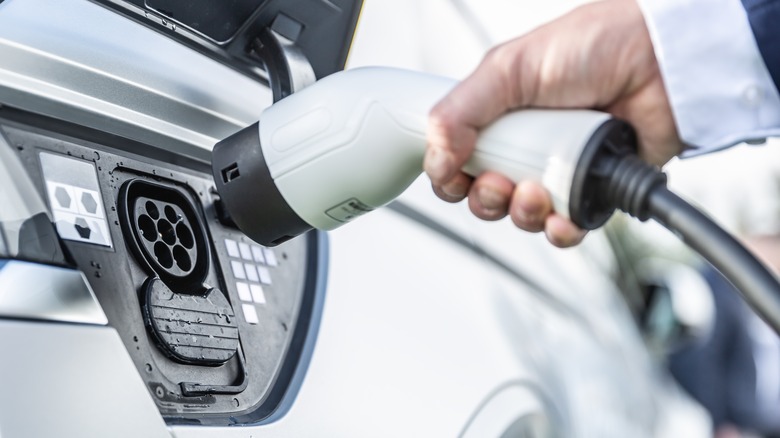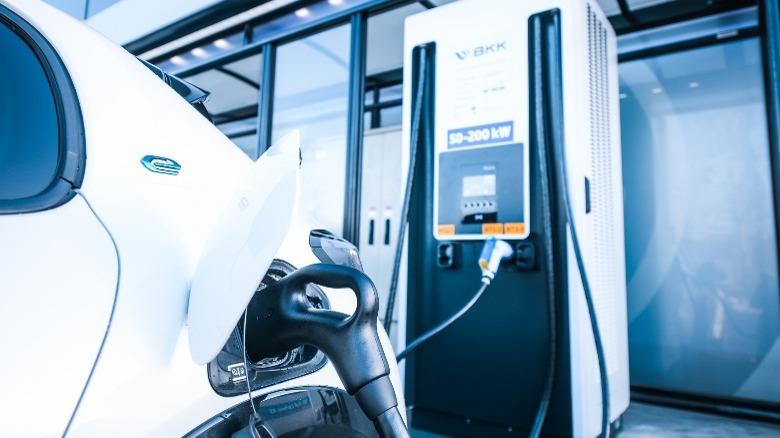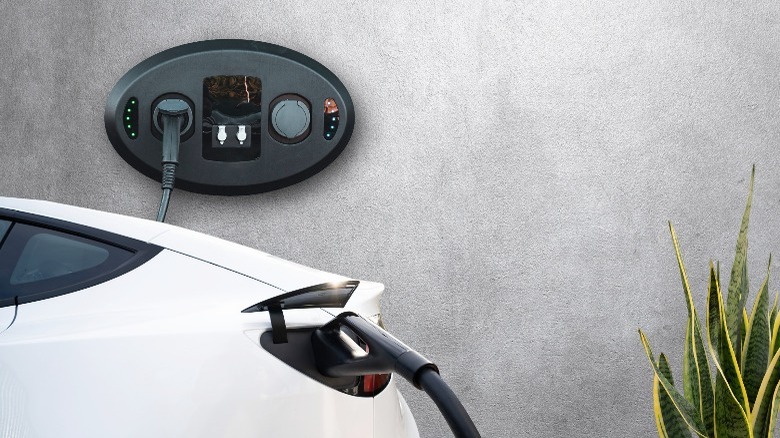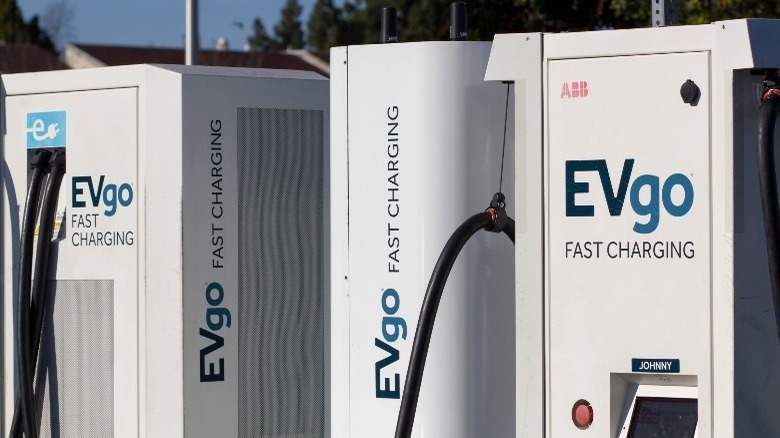Why Not Every Electric Car Charges At The Same Speed
If you're looking to buy an electric vehicle, and especially if you're planning on installing an in-home charger, it's important to know what the different charging specifications mean. Before diving into charging specifications, though, it's worth knowing how to measure these charging speeds. The important units are in kilowatts (kW), which tells you the rate of charge, and kilowatt-hours (kWh), which is a battery specification that informs you how much charge your battery can hold, and will have an effect on how quickly your car can charge to 100%.
To demonstrate the general idea, consider a vehicle with a 10 kWh battery; when connected to a 1 kW charger, that vehicle will charge to 100% in 10 hours. However, if you used a 5 kW charger in this same scenario, it would take only half of that time to charge the battery at five hours. As you may have guessed, a 10kW charger could recharge the battery in only an hour.
It's not entirely cut-and-dry as that, though, especially when it comes to fast charging. While a battery close to 0% will charge at or close to the full rated speed, as it gets closer to full, charging slows down to protect the battery — this throttled speed typically starts at 80% charge (via EVgo). At a basic level, charging speeds can be split up into two camps: slower AC-based in-home charging, and blazing-fast DCFC (direct-current fast charging) that you'll find offered by public charging networks like Tesla's Superchargers.
EVs charge the fastest with DC fast chargers
Direct current fast charging (DCFC), also known as Level 3 charging and DC fast charging, is the fastest kind of charging available to the electric vehicle world, coming in at anywhere between 50 kW and 350 kW. Not all DC fast chargers are made the same, though. While all DC fast chargers are found at public charging stations, some charging networks are faster than others. Even looking at one provider, you'll often see different levels of DCFC.
Electrify America, for example, features Ultra-Fast chargers at 150 kW in addition to Hyper-Fast chargers at 350 kW. The U.S. Department of Transportation estimates that a 60 kWh battery should charge from empty to 80% in anything from 20 minutes to one hour when connected to a standard DC fast charger.
Tesla Superchargers are another form of DCFC, although they only support charging at up to 250 kW, which Tesla claims can replenish up to 200 miles of range in 15 minutes. The unfortunate reality of DCFC is the limitation on location. Because they connect directly to the electrical grid and draw so much power, DCFC stations can only be installed as public charging stations and aren't suitable for in-home charging. When it comes to the latter charging method, you're limited to AC options.
You can use AC EV chargers at home, but they require patience
Whether it's a professionally-installed Level 2 unit or a plug-in Level 1 charger, there are serious limitations on both the current and voltage that AC EV chargers can pull from the grid. As YoCharge explains, AC chargers supply vehicles with alternating current, meaning the DC conversion is handed off to the vehicle's onboard charging circuitry, since batteries can only receive DC power.
Level 1 AC charging uses a standard 120-volt AC adapter and can be used on a regular breaker. Unfortunately, the low voltage and current draw also mean these chargers are as slow as molasses, maxing out at around 1 kW and taking up to 50 hours to fully charge a 60 kWh battery. The benefit of these low-power AC chargers is their compact size — often, they can be kept inside your vehicle as an emergency charger — and their conventional wall connector that allows them to go into just about any wall socket.
Meanwhile, Level 2 AC chargers step in-home charging up by using 208 or 240-volt circuits and can draw up to 80 Amps, delivering anywhere between 7 and 19 kW to your vehicle and charging a 60 kWh battery in anywhere from four to 10 hours, depending on the charger and vehicle's on-board charging hardware. This may be adequate enough for drivers who merely head to work in the morning and back home in the evening, as the car can be left plugged in to charge at night.
Why EVs charge faster at DC charging stations
DCFC stations are able to supply up to 350 kW of direct current to your vehicle thanks to a three-phase connection to the power grid, drawing up to 800 volts, according to SemaConnect. As Wallbox Chargers explains, DC fast charging is able to obtain such ludicrous charging speeds because the charger connects directly to the battery, bypassing the vehicle's internal charger to supply DC power.
Offloading the charging and current conversion duties to a larger standalone charger, as opposed to the internal vehicle charger, is a major benefit due to the size of the conversion hardware involved. Supplying DC power directly to the battery means the onboard charging hardware doesn't generate any heat, and the charging speed isn't subject to the current and heat limitations of the onboard charger.
DC fast charging doesn't come without drawbacks, though. There's debate about the matter, but there is certainly a case to be made for battery degradation from fast charging since it does cause elevated temperatures while charging. The charger type is only one aspect of EV ownership, though. Building good habits goes a long way to keeping your battery in good health and optimizing your range.



